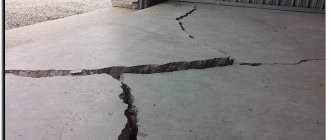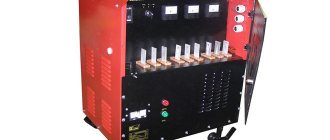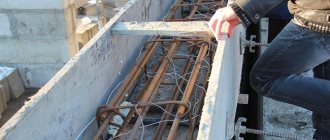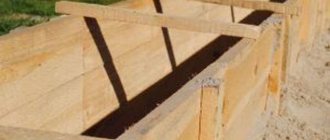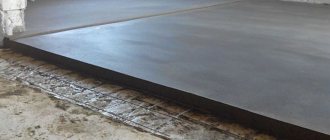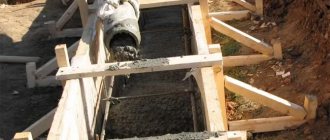Temperature sheet for heating concrete. Electrical heating of concrete structures with wire.
- View
- Video
- Characteristics
- Equipment
- With your own hands
- Adviсe
- Firms
When using concrete in construction, special attention is paid to the strength and durability of the material.
In order for Concrete to acquire the necessary properties and qualities, the manufacturing technology must be followed. How to warm up concrete. 8 ways. When using concrete in construction, special attention is paid to the strength and durability of the material. In order for Concrete to acquire the necessary properties and qualities, the manufacturing technology must be followed. But it is known that the solution contains water. Since it is not chemically bonded to the elements in the solution, freezing occurs when the ambient temperature drops. When water crystallizes, it increases in volume. As a result of the ongoing processes, additional stress is created in the concrete, which leads to the destruction of the material. For the Siberian region, frosts in winter (see photo of concrete heating in winter ) are a common occurrence.
For approximately six months in Krasnoyarsk, unfavorable temperature conditions for concrete hardening remain and use a temperature sheet for heating concrete . But a simple method was found that allows construction work to be carried out during the cold period. This is warming up. If you use concrete heating (for more details, watch the video of concrete heating ), then you can carry out work at subzero temperatures. Therefore, PSK “Building” does not stop selling concrete in Krasnoyarsk even in winter. To maintain normal temperature conditions, several methods of heating concrete . Here are the eight most effective: thermos; thermos with antifreeze additives and hardening accelerators; preheating the concrete mixture; electrode heating; heating in heating formwork; infrared heating; induction heating; heating with heating wires. Among the listed methods, electrode heating is considered the most effective. But using only one method does not provide a guaranteed result. In most cases, complex measures are used.
Let's take a closer look at each of the indicated methods. Thermos The technology consists of insulating the formwork. The type and degree of its insulation is selected based on the quality of the concrete and the ambient temperature. The calculations are based on the requirement: when concrete is cooled to a temperature of zero degrees, it must gain critical strength. Thermos with antifreeze additives and hardening accelerators The meaning of the method is intuitively clear from the name. The essence is to combine the insulation of the formwork with the addition of certain chemical reagents that accelerate the hardening process and slow down the freezing process. Preheating the concrete mixture This method consists of simply heating the mixture to a certain temperature. Heating is carried out before use - pre-heating. Electrode heating The essence of the technology is to pass electric current through concrete.
Due to this, the metal elements in the solution (rebar, special electrode) are heated, and as a result, the concrete itself is heated. Infrared heating The method is based on heating the surface under the influence of infrared rays. The heater works like the sun: it heats the illuminated surface, not the air around it. Induction heating This technology is based on the generation of heat under the influence of eddy currents. Eddy currents are formed under the influence of an electromagnetic inductor. Heating with heating wires This method of heating involves pre-fixing special heating wires to the reinforcement of a concrete structure. Current is then applied to the wires, causing the temperature to rise.
Electrical heating of concrete structures with wire.
Currently, electrical heating of concrete structures with wire is becoming increasingly widespread in construction, used both to ensure the pouring of concrete in winter and to intensify the strength gain of concrete at other times. In this connection, I would like to bring to your attention a methodological guide on heating concrete with a wire for electrical specialists in construction organizations whose responsibilities include heating concrete structures.
For the estimator and foreman: an article on calculating the full cost of work on electrical heating of concrete structures with wire (in FER and TER). Appendix: examples of practical calculations of material resources for typical structures of a reinforced concrete house. The electric heating power for the main structures is given. Appendix: transformers for electrical heating of concrete - basic design parameters and data sheets.
If you are interested in heating concrete, then it would be useful to familiarize yourself with the 42 (36) Volt phase sequence indicator, which is used for phasing power supplies of vibrators.
And, since you are a power engineer in the construction business, then look at the design of the traverse for introducing cable lines into cabins.
And perhaps you will be interested in the current regulatory framework for power tools:
“Convenience, quality of tools, equipment when carrying out all kinds of construction, installation and finishing operations turn out to be quite important. The construction market offers power tools of imported and domestic manufacture; the tools of Interskol, a Russian manufacturer, stand out especially. The constant demand of wholesale and retail customers, the justification of the price confirms his excellent recommendations for quality and durability. Quite often you need a tool or equipment more powerful than a common construction power tool, such as a drill or hammer drill. Powerful equipment, for example, is a welding unit, a household chainsaw, a semi-professional concrete mixer, etc. The key to saving money when purchasing this equipment and in the process of using it is the correct choice of such equipment. Such equipment varies quite significantly in terms of power consumption and, accordingly, efficiency. You need to have special knowledge and skills in working with professional concrete mixers and a welding machine, and periodically sharpen and refuel chainsaws.
It is imperative to know the regulatory documentation and safety rules when working with power tools. When purchasing equipment, you should take this into account and pay attention to quality, as well as subsequent use. Ignoring these conditions often leads to accidents and injury to personnel. Accidents often occur when welding or working with an angle grinder due to failure to take precautions and poor quality of the tool. Not less often, builders experience accidents from safety violations during high-rise finishing work. First, the scaffolding for construction and formwork must be made of first-class and strong material. Construction companies concerned about the safety of construction sites use permanent formwork and metal scaffolding. Strict compliance with all safety principles and construction requirements is another condition. A lot depends on the personnel of the construction site - they must be well trained and highly qualified within the boundaries of their specialty.”
Providing EPB technology
Insulation of heated structures. An important element of the EPS is to ensure minimal heat exchange between the heated structure and the environment. Improving the thermal insulation of concrete structures saves: • electricity spent per cubic meter of concrete; • funds spent on the purchase of technical equipment; • man-hours spent on installation and operational maintenance of EPS.
It is advisable to use formwork material as insulation. The use of 18 mm plywood as insulation showed its sufficient thermal insulation properties. It is advisable to protect heated structures, thermally insulated with plywood, from wind blowing (for example, with tarpaulin curtains). A significant source of heat loss from a concrete structure can be the evaporation of moisture from the surface. To prevent energy loss due to evaporation, poured concrete (exposed surfaces) should be isolated from the environment with a moisture-proof film.
Ensuring reliability. Technical measures to ensure reliability.
The reliability of the electrical power supply system for electricity sources can be achieved by the following measures (as the number increases, the reliability decreases): 1. establishing the 2nd category of power supply reliability for the construction site; 2. the use of autonomous means of power supply (diesel generators) located in cold reserve; 3. redundancy of inputs (power supply to an object from 2 or more transformer substations); 4. redundancy of input cables (power supply from different transformers of the same transformer substation).
An example of filling out a concrete heating temperature sheet
Control of concrete heating, calculation graphs
About summer concreting, read paragraph 5 of SP Load-bearing structures.
About winter concreting. As we warm up, we keep temperature sheets. There are plenty of them on the Internet.
No instructions. But there is clause 5.11 SP Load-bearing structures, MDS 12.48.2009 (MDS personally helps me a lot).
And heating of concrete is a type of work for which PPR is really needed when there is no experience. Those. more PPR
Fill out the concrete work log properly when you have a passport for concrete, temperature sheets with thermometer placement diagrams, test reports
#16 has already been posted here
Thank you, I will read it. I found .xls blanks for temperature sheets, and a calculation sheet with them, I attached it here, please read it. What to do with graphs? Are they absolutely necessary?
57 min. —— More questions have arisen. 1. It turns out that a new journal of concrete work has been created for winter concreting. What to do with the main (summer) concrete work log? Are both carried out in parallel? 2. How many winter concrete work logs should there be? The heating electrician has now stated that there are two copies, supposedly one from the engineering technician, and one from the electrician. Please explain. 3. Should the temperature sheets be kept by the electrician on duty? p.s. We do not have a work permit for winter concreting.
To be honest, I have never encountered such advanced temperature sheets as in option 2.
We rent without schedules.
Here in our registered journal (the so-called summer log) there is not enough column “average temperature in wells” and “duration of concrete curing, respectively. mode, hour." and “strength depending on the concrete grade according to the schedule, %”. What's missing is 3 graphs. Or will this just be replaced by temperature sheets?
p.s. newly printed “so-called the second - winter" magazine contains these columns..
47 min. —— Who looked at the Excel files attached? there is a “calculation” file and there are two pages in it.. they are really useful.. just need to understand the sequence of calculations. in theory, we fill in 1 graph for the structure.. and the file makes calculations in the form of interpolation depending on the given numbers under normal hardening conditions of concrete of the same grade (class or something else), we get the second graph - a graph of the theoretical strength achieved by (approximately) degrees-hours..
I think the files will help a lot of people, but my main question remains, what to do with the logs. and with graphs. p.s. I renamed the topic a bit...
How to calculate and fill out the concrete heating temperature sheet
The quality, reliability and strength of the completed concrete structures will depend on compliance with all conditions when pouring the solution. It is necessary to use a temperature sheet for heating the concrete, which will prevent cracking of the material, ensuring its maximum strength. Temperature indicators are especially critical in the winter season, when any deviation from the norm may lead to the need to refill the solution.
Basic requirements for the solution
Pouring and curing of concrete can occur within a narrow temperature range.
Today, special brands and varieties of Portland cement have been developed that can be worked with at subzero temperatures. However, standard varieties of this material still harden poorly at extreme temperatures, and at elevated temperatures the solution may rapidly lose moisture, which leads to cracking and other strength problems. Ensuring the correct temperature conditions, including additional heating of poured structures in the winter, will ensure excellent quality of completed building elements. That is why it is necessary to fill out a temperature sheet, and also take into account the permissible humidity levels in the room where construction work is being carried out.
Additional heating of concrete
When performing construction work in the winter season, there is a need for additional heating of poured concrete structures. This warming up can be done in various ways:
- Additional insulation and heating with a blowtorch.
- Electric heating mats.
- Ultraviolet installations.
- Use of heated formwork.
- Supplying voltage to the fittings.
The most primitive and at the same time effective way to warm up concrete is to arrange a warm area over which a tent made of cellophane film is erected. If necessary, you can install a heat gun or light a blowtorch inside such a tent.
This heating method is simple, but it can only be used for small volumes of concreting.
Electric mats are popular because they are easy to use. They are effective and allow for concreting both indoors and outdoors. All you need to do is pour the solution, wait for its initial hardening, then lay out the electric mats over the structure to be poured and set the regulator to the desired temperature. The disadvantage of electric mats is the difficulty of using them for large volumes of concreting. It is problematic to cover walls, columns and various vertical supports with mats.
Professional builders use ultraviolet installations to heat concrete, which do not involve contact with the heated solution. Thanks to the presence of radiation intensity adjustment, it is possible to reduce and increase the heating power. With equal success, such ultraviolet installations cope with thick formwork, allowing for high-quality heating of the building structures being built.
Temperature sheet calculation
All concrete used today fully complies with GOST; accordingly, the hardening time of the solution at certain temperatures has already been calculated . On the Internet you can easily find a completed sample temperature sheet for heating concrete, on the basis of which you can obtain all the necessary information about the curing time of the material at a specific temperature. It is not difficult to download such a form and standard filling out samples.
Based on typical examples of filling out a concrete heating temperature sheet, you can independently calculate the necessary data and, taking into account the current air temperature, select the optimal option for additional heating of the reinforced concrete structures being built. The use of such sheets will be relevant not only for professional builders, but also for ordinary homeowners who independently pour the foundation and various reinforced concrete structures. The sheets themselves can be downloaded on the Internet.
Professional builders use temperature forms with calculations, which contain data on the maturity of concrete, calculation of the average temperature in all shafts at a certain point in time after pouring the product. The use of such sheets with calculations allows you to obtain up-to-date information about the current state of poured reinforced concrete products.
The quality of poured reinforced concrete structures will largely depend on compliance with the temperature regime. To simplify the work with reinforced concrete products, temperature sheets for heating concrete were calculated. Using already completed standard samples, you can obtain all the necessary information about concrete hardening , which will be the key to performing high-quality work on the manufacture of reinforced concrete products.
Concrete heating control log
- Description
- Characteristics
vendor code 00004799
Concrete heating control log
The concrete heating control log is a working document during concreting and is used to record concrete temperatures. This log helps provide temperature control of the concrete mixture.
Construction work is often carried out in winter due to a number of objective reasons. In such conditions, it is necessary to ensure heating of concrete mixtures. Heating concrete when laying at subzero temperatures is necessary, since when water in the mixture freezes, the bonds are destroyed.
A concrete mixture poured without heating at subzero temperatures will not acquire the necessary strength characteristics and will not be able to withstand the necessary loads. Such a structure will be subject to accelerated destruction, which can lead not only to losses, but also to accidents.
In winter, not only the conditions and rules for pouring concrete change, but also the rules for preparing the mixture and its transportation. It is important to control the temperature at all stages of pouring the mixture. The frequency of temperature measurements depends on the method of heating the concrete.
Thus, when using steam heating, concrete heating is monitored every 2 hours at the initial stage. After eight hours, the frequency of measurements is reduced to once every four hours. A concrete heating control log is maintained and filled out by the foreman. Conduct temperature control of concrete at different points and at different depths. For this purpose, specialized tubes filled with oil are used. Measuring instruments are immersed in such tubes. By recording the results of such measurements in a log, temperature dynamics are monitored.
Books
Regulatory legal actsSocial and human sciencesReligion. Occultism. Esoterics Occupational health and safety Sanitary Pins, SP, MU, MR, GNP Gift books Travel. Rest. Hobby. SportsScience. Technique. MedicineSpaceRostechnadzorOtherArt. Culture. PhilologyBooks from the publishing house "Komsomolskaya Pravda"Books in electronic formComputers and the InternetUsed booksSNiP, SP, SO, STO, RD, NP, PB, MDK, MDS, VSNOGOST, OST Encyclopedias, reference books, dictionariesHome circleChildren's literature Academic year Collections of dish recipes for public catering establishmentsEconomic literatureFiction literature
The promised article about a magazine on concrete care
Greetings, friends! Today there will be an article that many people have probably been waiting for a long time, but they just can’t wait. Friends, in the article about the concrete work magazine, I promised to write to you about the concrete maintenance magazine. Here, by the way, is the promise.
And friends, this is the topic we will talk about today.
Preface
Ivan recently addressed me in the comments. He asked in the comments about the promised article about a magazine on concrete care.
Before his comment, I practically did not delve into or study this magazine. I promised him that I would provide a sample of the magazine within a day. When I began to study this issue more deeply, I realized that everything is not so simple here. This is what I answered him in the end.
About the magazine
In general, clause 5.11.17 of SP 70.13330.2012 states that “When the average daily outdoor temperature is below 5 degrees Celsius, a concrete temperature control log should be kept.” This is not a concrete maintenance log, but a concrete temperature control log. But the F-55 form of the concrete maintenance magazine is not quite right.
And here’s the most interesting thing - a sample concrete temperature control log is not in any regulatory document and you won’t even find anything on the Internet. This is a fact, friends. True, from today a sample of the magazine will appear on this site.
As I promised Ivan, I am writing this article because I received a response to my request from the Russian Ministry of Construction. They answered me quite clearly and even provided a sample of the concrete temperature control log. But not quite an established pattern (since there is none), but more of a recommended option.
Here is the letter itself:
1 sheet of letter
2 letter sheet
It follows from the letter that the form of monitoring the temperature of concrete in monolithic structures is of a recommendatory nature and, in particular, is given in Appendix 8 of the Manual on electrical heating of concrete in monolithic structures (to SNiP III-15-76).
And friends, I suggest you familiarize yourself with this form. This is not a concrete temperature control log, but a kind of temperature sheet. I will give you the opportunity to download not only a sample temperature sheet, but also the answers themselves from the Ministry of Construction of Russia and JSC Scientific Research Center “Construction”. You may need them if, during inspections, the temperature sheet that you will keep is not liked by the building control or construction supervision.
Download and use, but don’t forget to share the article on social networks. And many thanks to Ivan for his comment and persistence.
Filling
Like all magazines, filling begins with the title page
Title page
Data on the person carrying out the construction is entered here. The name of the object and address are also indicated. The journal is assigned a number and the start and end dates of the work are indicated.
The title page also indicates the responsible producers of the work and the number of sheets of the magazine. This completes the design of the title page.
The F-55 concrete maintenance log contains instructions for keeping the log:
Main table
It consists of 17 columns. All filling is intuitive. In column 3 it is necessary to indicate the surface modulus M2/M3, which is where many people have difficulties.
I will not describe here how to determine the surface modulus, but instead I will give a link to the article “Surface modulus of concrete (concrete structure in m2, m3) - what is it.”
Concrete heating temperature sheet
Heating concrete has significant potential for resource saving and cost reduction of construction projects.
The technology of thermal acceleration of concrete hardening under construction conditions must be carried out with complete efficiency: with the maximum speed of concrete hardening for given conditions, with high turnover of formwork, with minimal thermal cracking, with objective control of the temperature and strength of concrete structures. Specialists from JSC Scientific and Technical Center "ETEKA", candidates of technical sciences Lev Bekker and Sergey Trembitsky talk about this.
Hardening of concrete using modern Portland cement is a fairly long process at low positive (≤5°C) and, especially, negative air temperatures. Therefore, in winter it is necessary to use technical means that ensure accelerated hardening of concrete in monolithic reinforced concrete structures. This can be achieved by using activated or quick-hardening cements, chemical additives - anti-frost and hardening accelerators, by increasing the dosage of cement and reducing the water-cement ratio, or by using concrete of a higher class compared to the design grade.
But the most optimal and economically justified, in our opinion, is the use of thermal methods to accelerate the hardening of concrete. This technology is, in essence, resource-saving, since at the cost of reasonable additional energy and labor costs the opportunity is achieved: to reduce construction time by 5-10 times; effectively use labor resources and equipment, including capital-intensive formwork; use cheaper additive-free concrete mixtures; eliminate the possibility of concrete freezing at an early age and guarantee the required quality of concrete and structures.
Cost-effective rates of construction, namely, concreting structures (2-4 floors of an apartment building per month), are achieved in the winter if the period of curing the concrete in the formwork until the strength reaches 40-70% of its design value ranges from 2 to 5 days. Such a rate of growth in the strength of concrete is possible when it hardens under the conditions of an “expanded” thermos, which involves heating the concrete to 30-40°C, taking into account the existing electrical and thermal power at the facility. More intensive modes of heating and hardening of concrete are also possible, achieving a strength of 30-50% in 0.5-2 days in winter and summer, but requiring strict adherence to measures to prevent the appearance of temperature cracks.
At the same time, various thermal methods can be used to heat concrete of monolithic structures, and each of them has its own characteristics in terms of equipment, application technology and energy characteristics. The decisive factors when choosing a heating method are energy intensity, reliability, capital and operating costs.
A practically convenient, reliable and universal way to warm up monolithic concrete is to heat it with a heating wire. Heating wires of the brands PNSV-1.2 (1.4), POSKHV, POSKHP, PVZh, PPZh, PTPZh-2X1.2, PRSP, etc. are used. Experience shows that the thermal regime is based on the use of the peripheral heat of the heating wire and the heat of hydration cement, ensures heating of concrete fairly evenly throughout the volume of the structure. Therefore, temperature and thermal deformations throughout the volume of the structure change quite uniformly and cannot be the cause of the appearance of temperature cracks in the protective layer.
The reason for the probable appearance of surface cracks, most likely, may be insufficient tensile strength of concrete during rapid cooling of a large surface of concrete stripped and not covered with thermal insulation material, if its surface temperature, reduced by the amount of outside air temperature, exceeds the standard value. Compliance with the rules and regulations for the care of concrete after formwork ensures that structures are defect-free.
The strength of concrete at the early stage of its hardening should be monitored systematically, which is done by assessing the strength using statistical isothermal graphs or tables of hardening of concrete of a specific grade with continuous monitoring of the concrete temperature, as well as using an analytical computer program that approximates the statistical kinetics of hardening of concrete of various grades, using current measurements of concrete temperature, curing time and strength.
The systematic assessment of the current strength of concrete is based on a continuous statistical method, based in particular on pyrometric monitoring of changes in the surface temperature of concrete or formwork.
Warming up concrete in winter
Concrete was used back in the days of the Roman Empire, but the technology was subsequently lost and the “second coming” of the material took place only in the middle of the 19th century. It is almost impossible to imagine modern construction without the use of concrete mixture. However, construction in winter creates certain difficulties, because the material must be properly heated to obtain a high-quality result.
Features of “winter” construction
Low temperatures create significant problems for the construction of concrete structures. After all, the material is a mixture of cement, sand and gravel with water, which expands when frozen and can simply “tear” the monolith. The design strength of concrete is achieved only after 28 days, therefore, to maintain the quality of the structure, care must be taken to warm up the concrete. If the standards for maintaining temperatures above 0 degrees are not observed, the material becomes much less durable, and its service life is reduced significantly.
Concrete heating technologies
There are several ways to maintain the required temperature of the material, each of which has its own advantages.
Heat guns for heating concrete
This “old-fashioned” technology involves creating a special shelter for the structure. An awning is erected over the structure, under which heated air is pumped using heat guns. This method is used only on small objects, since the process of constructing a “tent” is too labor-intensive and expensive. The only advantage of this technology is the absence of the need to use electricity. If there is no access to the power grid, the use of autonomous heat guns may be the only possible way to warm up the concrete screed.
Thermal mats for heating concrete bases
To heat large horizontal surfaces, it would be more rational to use special electric heaters in the form of mats. To speed up the process, special additives are added to the concrete mixture to prevent water crystallization. However, such technology will be useless if columns or other complex structures need to be heated.
Heated formwork for heating vertical structures
A similar method is used to heat concrete walls and columns. Formwork is erected around the structure, which is additionally insulated, and heaters are installed on the inside. The advantage of concrete heating technology with heating elements is that there is no need to use complex equipment.
Electrode formwork is installed using strips of metal or rods that are attached at regular intervals from each other. The system is connected to a transformer, and here the water in the solution plays into the hands of the builders. Thanks to it, the material is heated. The method is optimal only for structures of standard sizes. But if we are talking about a non-standard design, you will have to use other technologies for heating the concrete.
Installing electrodes into the solution
The method is also used mainly for heating the concrete mixture during the construction of columns and self-leveling walls. Having poured the mixture into the formwork, electrodes are installed directly into the solution (usually in groups) and connected to a transformer. String electrodes can also be installed in advance by placing them along the entire frame.
Water in the mixture also plays the role of a conductor here, providing heating to the material. As the concrete hardens, the need for electrical current decreases. And after final hardening, the reinforcement remains part of the structure. The downside of this technology is the significant cost of electricity and the need to purchase large quantities of material for the electrodes.
Registration of thermometry results
The measured body temperature must be recorded in the logbook at the nurse’s station, as well as in the temperature sheet of the patient’s medical history.
The temperature sheet, intended for daily monitoring of the patient’s condition, includes thermometry data, as well as the results of measuring respiratory rate (RR) in digital form, pulse and blood pressure (BP), body weight (every 7-10 days), amount of alcohol consumed per day of fluid and the amount of urine excreted per day (in milliliters), as well as the presence of stool (with a “+” sign).
On the temperature sheet, days are marked along the abscissa (horizontal) axis, each of which is divided into two columns - “y” (morning) and “v” (evening). There are several scales along the y-axis (vertical) - for the temperature curve (“T”), pulse curve (“P”) and blood pressure (“BP”). In the “T” scale, each grid division along the ordinate axis is 0.2 °C. Body temperature is marked with dots (blue or black), after connecting them with straight lines, a so-called temperature curve is obtained. Its type has diagnostic value for a number of diseases.
In a healthy person, body temperature can fluctuate from 36 to 37°C, and it is usually lower in the morning and higher in the evening.
Situations in which erroneous thermometric data may be obtained are as follows.
The nurse forgot to shake the thermometer.
The patient has a heating pad applied to his arm, on which body temperature is measured.
Body temperature was measured in a seriously ill patient, and he did not press the thermometer tightly enough to the body.
The mercury reservoir was located outside the armpit area.
Simulation of patients with elevated body temperature.
A hygrometer is a device that allows you to control the microclimate in a room. The psychrometric device allows you to identify current indicators of temperature and relative humidity. A special logbook allows you to monitor the microclimate every day, record basic data and subsequently study them.

